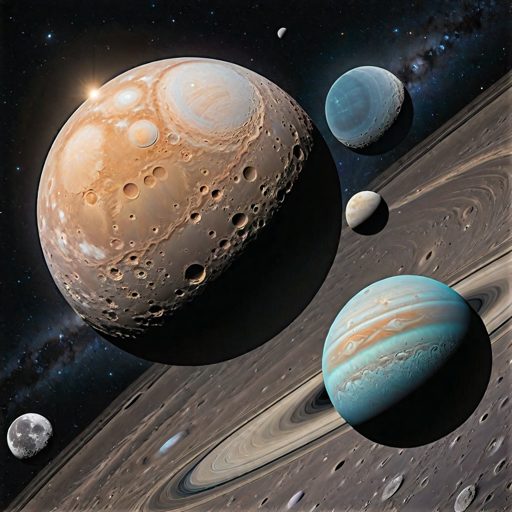
Shakespeare and Greek Myths: New Moons
Recommended for Exploration
Exploring New Frontiers: The Discovery of Three New Moons
The cosmos has always been a canvas of curiosity for us earthlings. Recently, the cosmic family welcomed three new members around Uranus and Neptune, stirring excitement and wonder. Here’s a closer look at these celestial discoveries, soon to be named after characters from Shakespeare’s plays and Greek mythology.
Unveiling New Celestial Bodies
- International Recognition: The International Astronomical Union (IAU) has acknowledged three new moons, enhancing our understanding of Uranus and Neptune’s lunar families.
- Literary and Mythological Names: Reflecting a tradition, these moons will carry names inspired by Shakespeare and Greek goddesses, adding a touch of poetic grace to the scientific discovery.
A Closer Look at the Moons
-
Uranus’ Tiny Companion: S/2023 U1
- Size: Uranus has a tiny new companion named S/2023 U1. It’s really small, just about 5 miles wide, which makes it one of the tiniest moons we’ve found in our solar system.
- Orbital Period: This little moon takes a long time to go around Uranus, about 680 days for one complete orbit. Isn’t that interesting?
- Future Name:
- Soon, it will get a name like the other moons of Uranus, which are all named after characters from Shakespeare’s plays. We think that’s pretty awesome because it mixes astronomy with literature. Imagine floating in space next to such a small moon, taking your time to circle around a giant planet like Uranus.
- And then, getting a name that comes straight out of a play written hundreds of years ago. It’s like a bridge between the past and the present, right there in the vastness of space
-
Neptune’s New Satellites: S/2002 N5 and S/2021 N1
- Sizes: They are quite fascinating! The first one, S/2002 N5, is about 14.3 miles wide. On the other hand, S/2021 N1 is smaller, with a width of approximately 8.7 miles.
- Orbital Periods: These moons take their time orbiting Neptune. For S/2021 N1, it takes 9 years to complete one orbit around Neptune. Meanwhile, S/2002 N5 takes much longer, nearly 27 years, to do the same.
- Naming Inspiration: The names for these satellites come from a cool place! They will be named after the Nereids, who are characters from Greek mythology. This makes the discovery even more interesting. It’s like a blend of science and stories from the past. How awesome is that?
The Discovery Process
- Astronomers discovered new moons using ground-based telescopes. This shows how powerful modern astronomy is. They used special image processing and long exposure stacking. This technique helps see the moons clearly against the stars. It was tough, though. The moons are faint and far away. But with careful watching and advanced tech, the astronomers managed to see them. They worked really hard to overcome these challenges.
The Significance of These Discoveries
- We learn more about the outer planets’ moons, growing our knowledge. Ground-based telescopes and image processing show their power by finding far-off space wonders. Naming these moons after characters from stories and myths links science with literature, making the story of space discovery even more interesting.
Beyond Uranus and Neptune
- Jupiter and Saturn’s Moons: Recent years have seen a surge in moon discoveries, with Jupiter and Saturn’s moon counts reaching 92 and 145, respectively.
- Technological Advancements: These discoveries are testament to the evolving techniques and technologies in astronomy, allowing us to uncover more of the universe’s secrets.
Conclusion: Looking Up and Beyond
The discovery of these three new moons around Uranus and Neptune is a remarkable achievement in space exploration. It not only expands our cosmic knowledge but also bridges the gap between science and the humanities, through the naming of these celestial bodies.
As we continue to gaze upwards, the universe reveals more of its mysteries, reminding us of the endless possibilities waiting to be explored.
Let’s keep our eyes on the stars and our minds open to the wonders they hold.
Watch a video
Neptune’s Lunar Delight: Exploring the Moons of Mystery!
Curious Times is a leading newspaper and website for kids. We publish daily global news aligned to your learning levels (also as per NEP 2020): Foundational, Preparatory (Primary), Middle and Senior. So, check out the News tab for this. We bring kids’ favourite Curious Times Weekly newspaper every weekend with top news, feature stories and kids’ contributions.
Curious Times News Program for Schools for FREE. Over 5,000 schools and teachers from all over the world have joined our programme so that students and teachers can get FREE Educative Newspaper. Here, kids can take part in world events and win prizes and certificates for free through their schools.
The following social media platforms allow you to communicate with us: Instagram.
0 (Please login to give a Curious Clap to your friend.)
